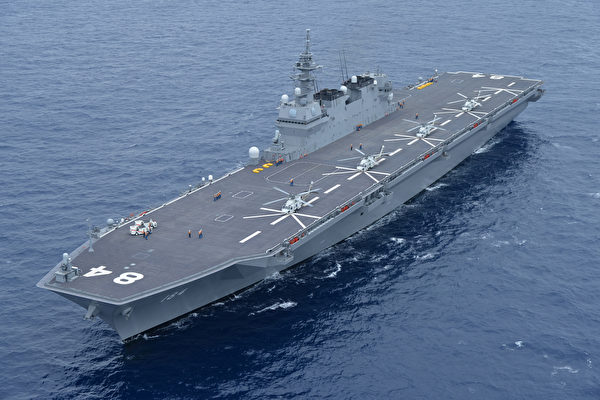Japan’s newly refurbished light aircraft carrier is set to conduct takeoff and landing tests of F-35 “Lighting II” stealth fighters with the assistance of the U.S. military. This marks the latest milestone in the ongoing cooperation between the U.S. and Japan in the F-35 fighter and aircraft carrier sectors, as well as progress in jointly countering China’s maritime bullying.
The Japanese have transformed a helicopter destroyer into a light aircraft carrier capable of carrying F-35B stealth fighters, marking the completion of the first conversion work to create a light aircraft carrier. This is part of Japan’s efforts to strengthen its defense capabilities in the surrounding airspace and sea areas to counter China’s expanding military presence in the region.
The Japan Maritime Self-Defense Force announced on Tuesday that this fall, the refurbished light aircraft carrier, the JS Kaga (DDH-184), will travel to the U.S. for F-35B carrier-based aircraft takeoff and landing tests.
From October 5th to November 18th, the JS Kaga will conduct actual operational tests of F-35B near the coast of San Diego, California, with the assistance of the U.S. Marine Corps and Navy, including repeated short-distance takeoffs and landings, as well as aircraft storage in the carrier’s hangar.
The F-35B is capable of achieving short takeoff and vertical landing by rotating its thrust nozzle downward to provide lift. In 2021, the Maritime Self-Defense Force conducted takeoff and landing tests of two U.S. F-35Bs on another light aircraft carrier, the JS Izumo (DDH-183), to check the heat resistance of the upgraded light aircraft carrier deck.
The JS Kaga has just completed the transformation from a helicopter carrier to a carrier capable of launching and recovering F-35B fighters. Once the JS Kaga and JS Izumo both receive full certification for successful jet fighter takeoffs and landings, Japan will have naval capabilities unprecedented since World War II.
The JS Kaga resembles the U.S. Navy’s big-deck amphibious assault ship, which has been previously used by the U.S. Navy as a “Lightning Carrier,” a smaller and lighter warship than an aircraft carrier with a flight deck specifically designed for F-35B aircraft.
One of the latest examples of this concept is the USS Bonhomme Richard, an amphibious assault ship that recently entered a maintenance phase after combat with Houthi fighters in the Red Sea to be refitted to accommodate F-35 fighters.
The U.S. Navy can concentrate more aircraft carriers in the form of amphibious assault ships. These ships are designed to support Marine Corps amphibious operations, carrying a squadron of F-35B “Lighting II” stealth fighters, turning these ships into something akin to the Casablanca-class light aircraft carriers used by the Navy in World War II, which generally carried 27 aircraft.
The JS Kaga is scheduled to begin its deployment in the Indian-Pacific region in 2024, marking its first deployment post-refurbishment. With the upgraded JS Kaga able to operate fifth-generation multi-role stealth fighters.
The U.S. and Japan are increasingly engaging in close military cooperation to jointly curb China’s hostile actions in the East China Sea and South China Sea. For Japan, the ability to deploy its own or U.S. F-35B fighters on refurbished light aircraft carriers in the tense situation in the Indian-Pacific region, particularly against the backdrop of China’s continued assertiveness, could prove to be a significant deterrent against China.
While Japan boasts a long history of aircraft carriers and was among the earliest navies to effectively use aircraft carriers, the ongoing upgrades signify a milestone for the Japanese Navy in the modern maritime era.
Japan began significant reforms of its Self-Defense Forces in October 2021, establishing its first amphibious force since World War II and introducing new modern escort vessels, announcing the transformation of two Izumo-class helicopter destroyers into light aircraft carriers.
The Japan Maritime Self-Defense Force plans to complete the transformation of two helicopter destroyers into actual “carriers” by 2027.
Japan’s light aircraft carrier will be another significant rival to China, with the added capabilities of F-35B fighters further enhancing the Japanese Navy’s strength. Coupled with strengthened military cooperation between Japan, the U.S., and other countries, all these developments are causing unease in China.
In December 2022, then Commander of the U.S. Seventh Fleet, Vice Admiral Karl Thomas, stated that the U.S. light “Lightning Carrier” is far more capable than the operational carrier capabilities of the Chinese.
The F-35B “Lighting II” fighter is a short takeoff and vertical landing variant of the F-35 joint strike fighter, a fifth-generation fighter with advanced capabilities. In addition to serving as a short takeoff and vertical landing (STOVL) jet aircraft, a major advantage of the “Lightning Carrier” is the F-35B’s advanced sensor array, enabling the aircraft to act as a battlefield hub and relay information to friendly forces across a wide area.
“There is no comparison between the J-15 and the F-35B,” Thomas said. The J-15 is China’s primary carrier-based aircraft.

